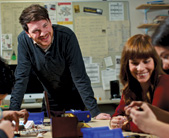Tinkering with scholarship
UVic's Maker Lab in the Humanities
by Peigi McGilvary

(left to right) Zaqir Virani,
Jentery Sayers, Nina Belojevic
and Katie McQueston.
PHOTO: NIK WEST
"The critical 'making' going on at the Maker Lab is among the most exciting research I've seen in the last five years," says Ray Siemens, Canada Research Chair in Humanities Computing and Distinguished Professor in UVic's Faculty of Humanities. "It is a whole new approach to scholarship that builds significantly and positively on traditional types of academic analysis."
Under the inspirational leadership of English professor Jentery Sayers, the Maker Lab is designed to blend humanities research with a collaborative "makerspace," where graduate students and faculty make projects that incorporate computer programming, data modeling, 3D printing, and prototyping. "Increasingly, students interact mostly through their screens," says Sayers. "I want them to step away from screens, make something and become active participants in their learning."
The Maker Lab is inspired by experimental art and literature, interaction design, and an emerging do-it-yourself (DIY) culture, called the Maker movement, where people—hobbyists, engineers and enthusiasts of all ages—collaborate and learn by designing and making things themselves. "Makerspaces are popping up in many communities," says Sayers.
"People are taking DIY in a new direction using circuit boards, robotics and 3D-printed objects. Creating a space where we can bring that kind of collaboration and creative thinking to humanities research has been very rewarding. It also draws the university and surrounding communities together through shared interests in making things."
Sayers points to a project called "Kits for Cultural History" as an example of the innovative research underway at the lab. "I'm working with a team from UVic and Western University in Ontario to develop a series of kits that provide information and materials so people can reconstruct 19th- and 20th-century technological experiments. The materials for each kit are based on museum collections from across Canada, and they are designed to reflect the historical contexts of the original experiments," says Sayers. "It's a rich, hands-on way to delve into the culture of technology, and it's exciting to see how it draws people into museum collections and inspires new kinds of exploration."
The Maker Lab's innovative approach puts it at the forefront of digital humanities research. The Social Sciences and Humanities Research Council has recently recognized its value and awarded a four-year grant to fund the lab's work with computing, electronics and history. As part of the grant, Sayers and students in the lab will be conducting public workshops about socially conscious approaches to new and old technologies.
"The Maker Lab brings students in as co-researchers," says Siemens. "They are learning by doing, with leaders in the field. When you walk into the lab, you can feel their excitement and witness a new, very important kind of academic collaboration."
There are currently 16 students researching and making projects at the lab. In partnership with the English department's Modernist Versions Project, the Maker Lab's research priority areas are physical computing (using hardware and software to design physical interactions), desktop fabrication (3D printing and milling), versioning (tracing change across iterations of text and other media) and scholarly exhibits of historical materials.
"The projects that team members are working on involve a broad range of technologies, methods and archives, but they all invite hands-on interaction with objects, and involve experimenting and speculating about history and culture," says Sayers. "At the Maker Lab we're expanding the means and modes of humanities scholarship, with an investment in public knowledge."
View as PDF (500K).
Humanities meets computing
Jentery Sayers' research interests include comparative media studies, digital humanities, modernism, and project-based learning. His work with and about technologies has appeared in a variety of scholarly journals and collections, and his first book (due out soon, with the University of Michigan Press) is a cultural history of magnetic recording.
Ray Siemens has published several editions and collections on Renaissance literature and the digital Humanities, and is the founding editor of the electronic scholarly journal, Early Modern Literary Studies. He has written many articles about the intersection of literary studies and computing methods.
The Kits for Cultural History team includes Jentery Sayers, Nina Belojevic, Alex Christie, Jon Johnson, Shaun Macpherson, Nancy MacWhirter, Katie McQueston, and Zaqir Virani at UVic, and William Turkel and Devon Elliott at Western University.
The Maker Lab's research is supported by the Social Sciences and Humanities Research Council of Canada, UVic's Faculty of Humanities and Department of English, the Modernist Versions Project, the Electronic Textual Cultures Lab, and the Digital Humanities Summer Institute.
For more information on the Maker Lab, visit http://maker.uvic.ca/
To learn more about digital humanities at UVic, visit http://bit.ly/1chAzTn
